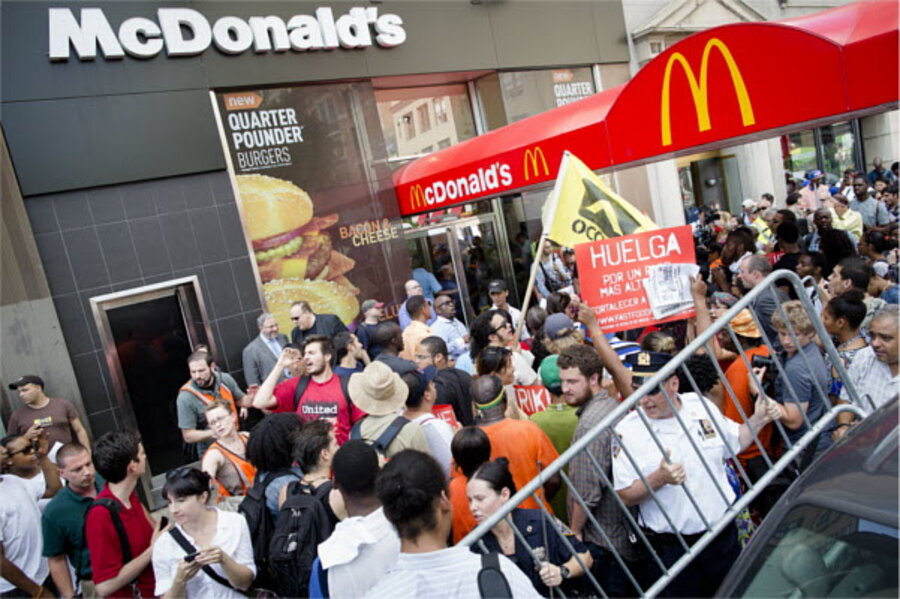Schooled by Occupy movement, fast-food workers put demands on the table
Loading...
| New York
Along with thousands of fast-food workers in at least seven cities this week, Naquasia LeGrand decided to walk off her job at KFC for a day and demand a “living wage” of $15 an hour.
Chanting “we can’t survive on seven twenty five” – a reference to the federal minimum wage – Ms. LeGrand marched with hundreds of other workers yesterday in a nation-wide effort to draw attention to what they say is an ever-widening income gap.
New York’s contingent of protesters, some of whom carried signs saying “supersize my pay,” demonstrated all day in front of a number of McDonald’s, Wendy’s, and KFC’s throughout Brooklyn and Manhattan.
It is a scene playing out in other cities as well: Kansas City fast food and retail workers walked out Tuesday, and Milwaukee workers plan their one-day strike on Thursday. Chicago, Detroit, and St. Louis workers have also walked off the job – each asking for a $15-an-hour wage and the ability to unionize without reprisals from their employers.
This week’s strikes cast light on a simmering social movement of media-savvy youth and urban low-wage workers that began with the Occupy Wall Street protests nearly two years ago.
Like the Occupy movement, the walkouts this week arose from a parallel form of community organizing – rather than a hierarchy of leadership from above. Workers have been mobilizing through social media – even as a host of community organizers redouble their commitment to traditional pavement pounding and grassroots gatherings.
Call it Occupy 2.0. Organizations with Twitter-ready names such as “Low Pay Is Not OK” and “Fast Food Forward” have helped galvanize the workers, and hashtags such as “#strikefor15” and “#iamfastfood” have instantly shared pictures of the protests and pin-pointed their locations in real time.
“The Occupy movement created sort of a consciousness, a political space to talk about income inequality, and these workers really relate to the idea of the 99 percent,” says Hilary Klein, director of Make the Road New York, a community advocacy group with offices throughout the city.
“So I think there has been a real upsurge in low-wage organizing in general since then,” continues Ms. Klein, who helped coordinate this week’s protests.
“Workers are saying, enough is enough, it’s time to organize, it’s time for something to change,” she says. “So I think the fast food strikes that you’re seeing this week are just one of a whole series of low-wage workers in different sectors organizing to unionize, to demand a living wage, and to say, ‘We deserve more respect and dignity on the job.’ ”
Yet while the strikes have received support from unions such as the Service Employees International Union (SEIU), headquartered in Washington, D.C., many are skeptical that a fast-food workers' union is viable, simply because of the nature of the business. The National Restaurant Association estimates that fast food restaurants have 75% employee turnover rates, for example.
“This walkout seems to be more for public opinion and educating,” says Ed Wertheim, professor of management and organizational development at Northeastern University in Boston. [Editor's note: The original version of this story misspelled Ed Wertheim's last name.]
“Organizing for this large of a group of workers is extremely difficult, and many of these people are not going to stay in and continue the fight,” he says. “Many can and will decide to move on and get a job that pays more – ostensibly abandoning ship for the next group of workers to inherit the problem.”
But unions recognize that with membership still on the decline, these types of sectors of low-wage workers – who are often urban immigrants and minorities – may represent a new constituency.
“I think there’s been a real effort on the part of labor unions and community organizations to work together to collaborate, to say, what can we do to make these strikes real?” says Klein.
“We are proud to support these workers,” says Mary Kay Henry, president of SEIU. “The best inspiration has been from the workers, because this is a very dramatic action.... It’s not an easy decision to make, it puts pressure on families, but I think it represents how determined people are to turn things around, not just for themselves, but for their families and communities.”
Like many of the young protesters this week, LeGrand, who works at two KFC restaurants, one in Brooklyn and another in Queens, was surprised at how energized the protests made her feel. She even was able to stand up and speak to hundreds of people gathered near Prospect Park in Brooklyn – something she had never done before.
“It just felt good,” she says. “I just enjoyed how this campaign is getting bigger and stronger – every time I come out, it’s always the biggest crowd, it’s always more people, more media, more clergy. And you know, it felt so good.… Young people are part of this campaign, and we as a community are coming together to better our people and the future.”








